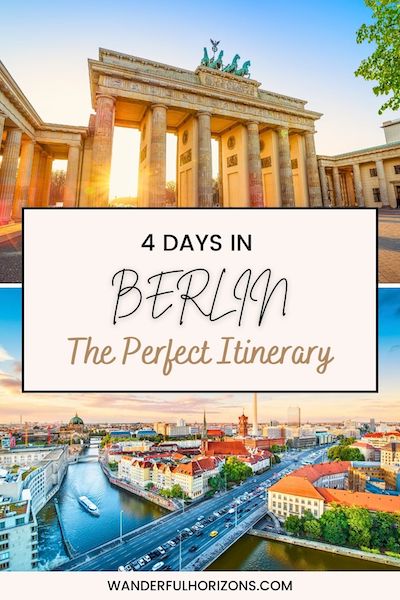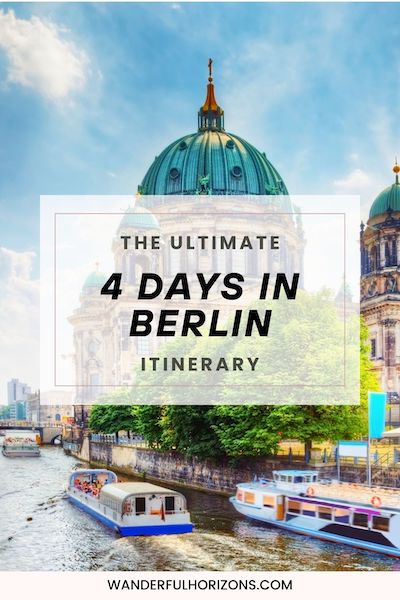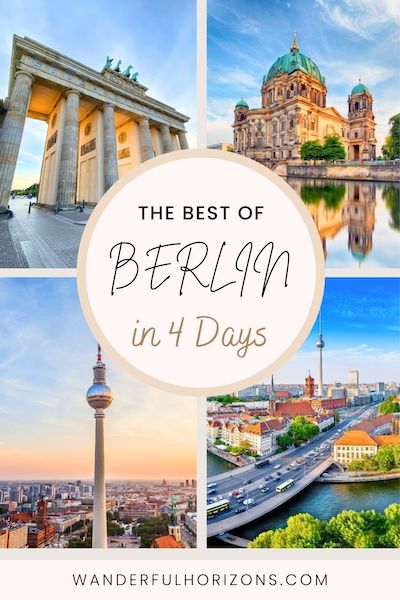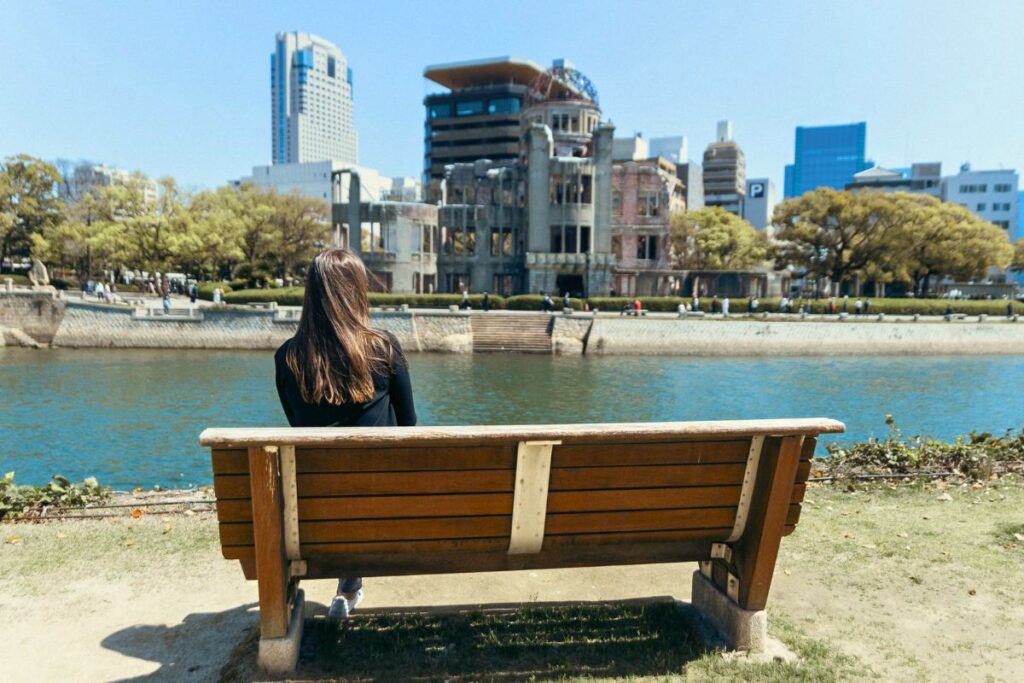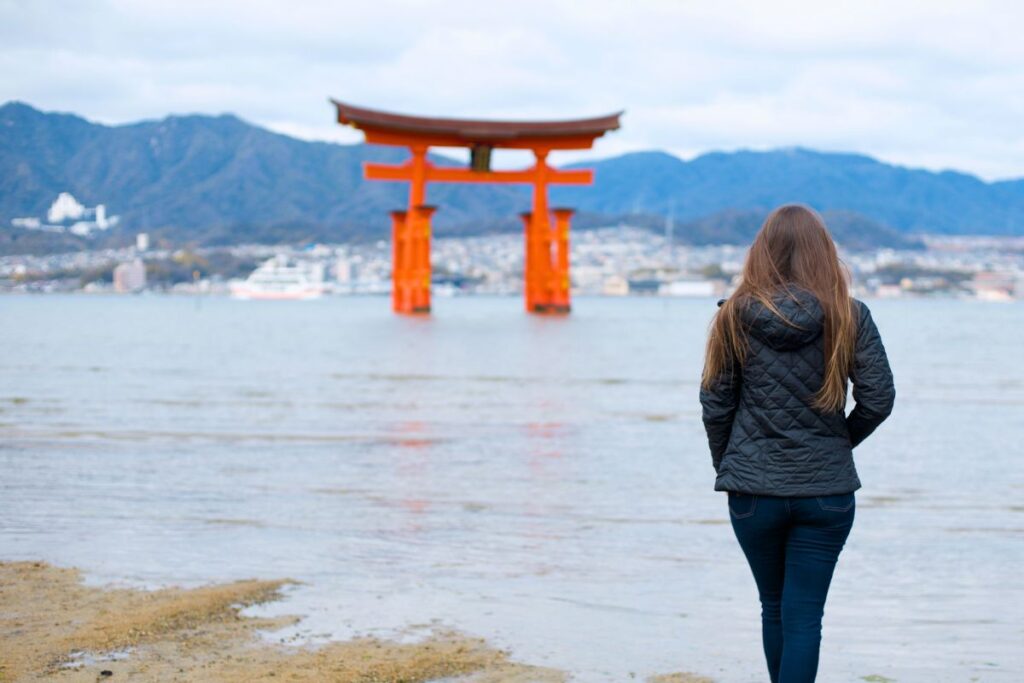
Last updated on March 2, 2024 by Krysti
Are you interested in spending 4 days in Berlin, Germany? Then look no further! Because I’ve got you covered with this ultimate 4 day Berlin itinerary!
Known for its historical landmarks, diverse architecture, vibrant cultural scene, thriving nightlife, and unforgettable cuisine, Berlin is one of Germany’s top destinations – and its capital city.
A hot spot for tourists, students, and locals alike, this incredible city offers much to be discovered and explored. So much so that I personally keep coming back to visit!
In fact, I spent a semester of college studying abroad in Berlin. And then came back again during my European honeymoon – my husband had never been, so obviously I had to take him!
Needless to say, I have a soft spot for Berlin. And well, I’m always ready and way too excited to share all of my recommendations and tips.
So, without further ado, let’s jump in and discuss everything you need to know to discover the best of Berlin in 4 days.
Best Time to Visit Berlin
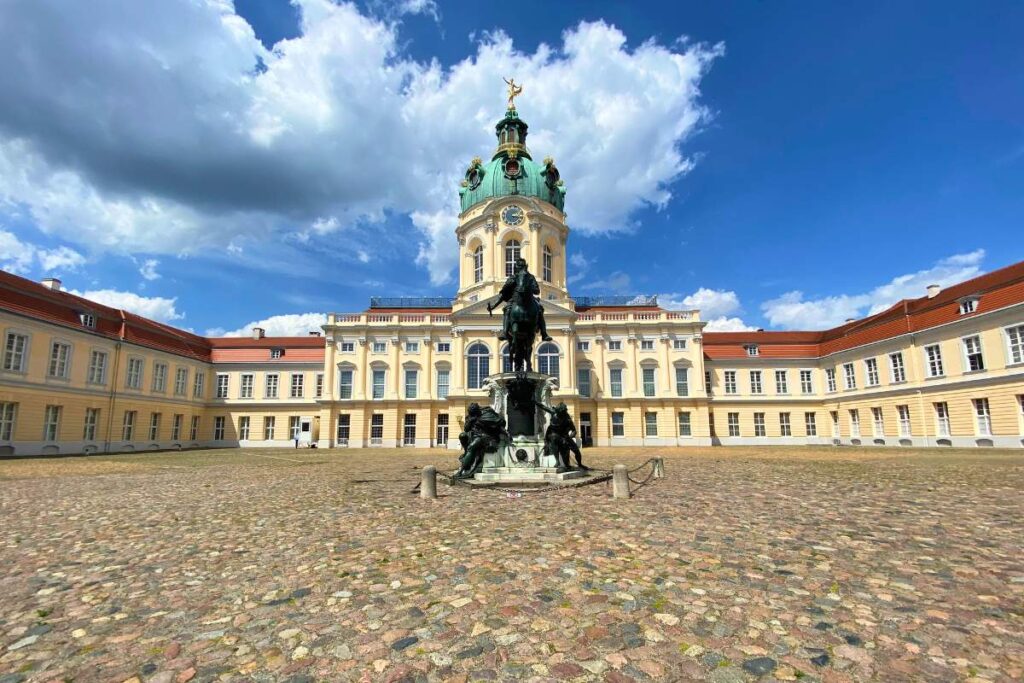
Charlottenburg Palace is an incredible place to visit year round!
In truth, Berlin is an incredible destination to visit any time of the year! Each season brings with it its own advantages and perks – it all just really depends on what you’re looking for.
That being said, most tourists travel to the city during the summer between the months of June and August.
Around this time of the year, the weather is comfortably warm and sunny. The days are long, allowing for more exploration. And the nights are calm and mild.
However, it’s also peak travel season for Berlin, so you’re likely to encounter more crowds, longer wait times, and higher prices.
If you wish to avoid this, you can instead travel during the shoulder season in late spring (April-May) or early fall (September-October).
This time of the year offers fewer crowds, lower prices, and mostly pleasant and mild weather.
It’s also a beautiful time of the year to visit the city. During spring, you can expect to encounter an array of blooming flowers, while fall brings vibrant autumn foliage.
Last but certainly not least, we have winter. And I’ll be honest – winter in Berlin gets quite cold (like below-freezing cold)! So if you’re not a fan of chilly weather, I suggest that you wait and visit the city another time.
However, if you don’t mind the cold, Berlin can be a fantastic winter destination, especially around the holidays. The entire city lights up, and Christmas markets pop up all over the place – it’s a truly magical time of the year in Berlin!
A Note On Oktoberfest
Oktoberfest is an incredible cultural event that I highly recommend checking out if you are interested in doing so. However, it’s also worth noting that this is a very, very busy time in Germany. I would even go so far as to call it a second-peak travel season. As such, tourist numbers increase significantly, which means prices do as well. If you plan to visit Germany but have no intention of partaking in Oktoberfest, then I would avoid traveling during this time of the year.
The dates for Oktoberfest fluctuate; however, the festival is typically held for a couple of weeks between the end of September and the beginning of October.
How to Get to Berlin
Depending on where you’re coming from, you’ll likely fly or take a train into Berlin.
If you plan to fly, you’ll want to land at Berlin’s new airport, the Berlin Brandenburg Airport (BER).
Opened in 2020, BER is now the city’s one and only airport. It was built to replace two former airports that used to service the area – the Berlin Schönefeld Airport and the Berlin Tegel Airport.
Located in the neighboring state of Brandenburg, BER lies about 30-45 minutes outside the city center. You can travel between the airport and the city via train, bus, or taxi.
On the other hand, if you’re coming from another European city, you’ll likely end up traveling by train, especially if you’re utilizing a Eurail pass.
There are several train stations throughout the city; however, the Berlin Hauptbahnhof (also known as Berlin Central Station) is the main train station for Berlin.
How to Get Around Berlin
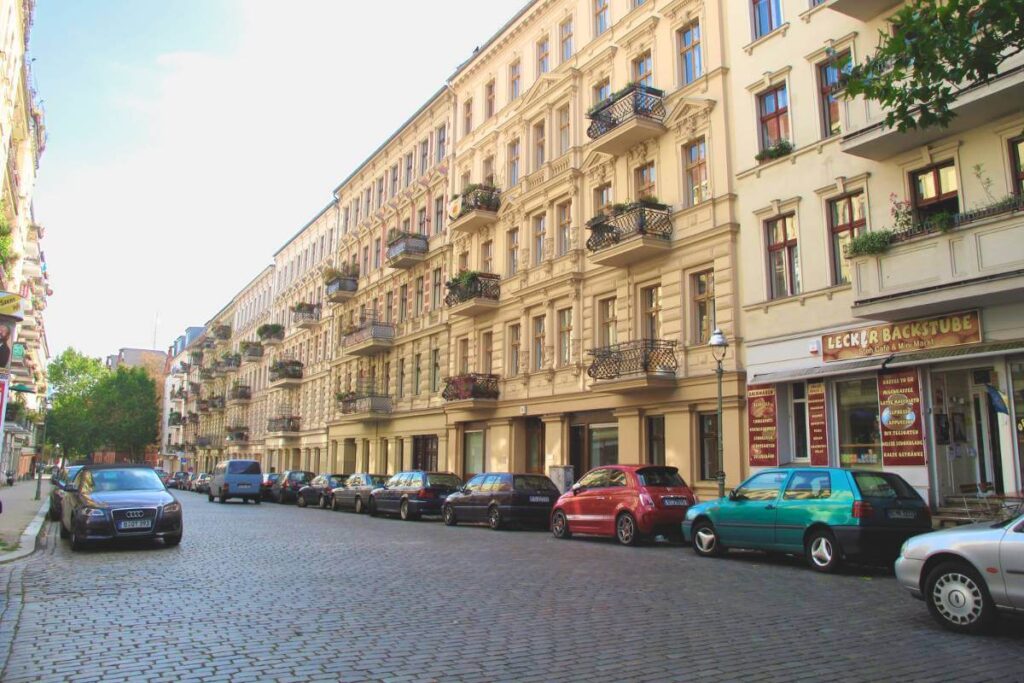
Berlin is a very walkable city full of cute cobblestone streets and historic buildings.
Like many other European cities, it’s very easy to get around Berlin. Not only is the city walkable, but public transportation is also widely and readily available.
I mean, when I lived in Berlin, I almost exclusively used the S-Bahn (trains) and U-Bahn (subway) – because they are literally everywhere. And on top of this, the city offers public buses, trams, and even a few ferries.
Tickets are super affordable and can be used across all transportation types. You can find ticket kiosks at subway and train stations. And you can also buy them while on trams and buses.
In addition to this, there are a few mobile apps that sell digital tickets for the city’s public transportation. BVG is the one that currently seems to be the most popular.
Pro Tip: Berlin also offers a tourist pass called the “Berlin Welcome Card.” While there are a few different types for you to choose from, most include public transportation passes and discounted or free admissions to certain attractions. It’s a great option to consider if you hope to explore as much of Berlin as possible in 4 days.
Map of Berlin
To help you plan your Berlin trip, here’s a map overview of all the destinations mentioned in this Berlin 4-day itinerary.
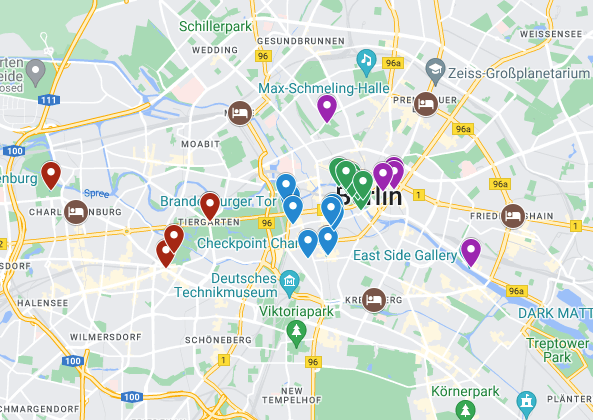
If you’d like to view an interactive version of this map, click here!
Berlin in 4 Days: An Overview
Don’t have time to read the article in full? Here’s a quick recap of my suggested itinerary for 4 days in Berlin.
- Day 1 – Berlin’s Top Sights: Visit the Brandenburg Gate, the Memorial to the Murdered Jews of Europe, the Reichstag Building, Checkpoint Charlie, and Gendarmenmarkt.
- Day 2 – Historical Berlin: Explore Alexanderplatz, the Berlin TV Tower, the Berlin Wall Memorial, and the East Side Gallery. Join a food tour.
- Day 3 – Museum Island: Spend the day enjoying Berlin’s museums. Visit a few of the following: Altes Museum, Neues Museum, Bode Museum, Pergamon Museum, Alte National Gallery, and the DDR Museum. Stop by the Berlin Cathedral.
- Day 4 – West Berlin Highlights: Discover West Berlin and visit the Charlottenburg Palace, the Kaiser Wilhelm Memorial Church, and the Tiergarten Park. Join a boat tour along the Spree River.
Berlin in 4 Days: Explained
Now that we’ve made it through the logistics let’s dive in and discuss in detail the perfect Berlin itinerary for 4 days. I’ve included many options for you to consider and a few additional day trips if you decide to extend your stay. Feel free to pick and choose and adapt this itinerary as you see fit!
Day 1: Berlin’s Top Sights
On your first day in Berlin, I recommend hitting up the city’s most popular attractions. I’ve included several for you to check out; however, don’t feel too pressured to see it all. This first day will vary depending on when you arrive in Berlin and how much time you have to explore the city.
Marvel at the Brandenburg Gate
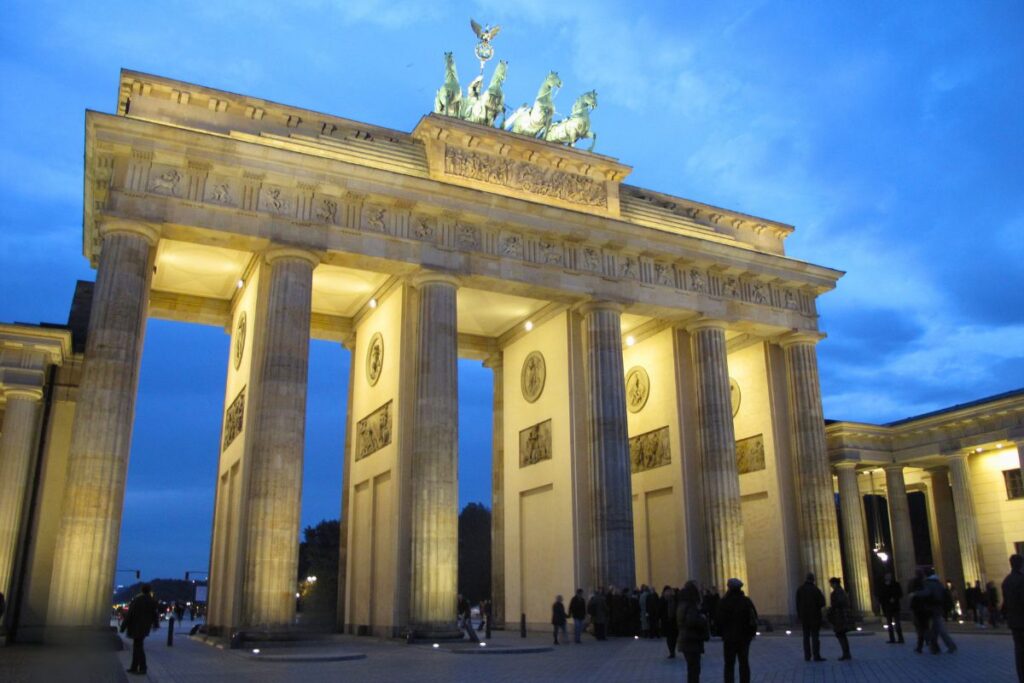
The Brandenburg Gate is, without a doubt, the most iconic landmark in Berlin. And one that signifies peace and unity for the city.
Originally built in the 18th century, the Gate played an important role during the Cold War and the fall of the Berlin Wall.
At the height of the Cold War, when Berlin was divided into East and West, the Brandenburg Gate resided in a restricted area that couldn’t be visited by anyone on either side of the city. It wasn’t until the fall of the Wall and the reunification of Berlin in 1989 that the Gate became accessible again.
Since then, the Brandenburg Gate has become an iconic symbol of Germany and Berlin’s reunification.
Reflect at the Memorial to the Murdered Jews of Europe
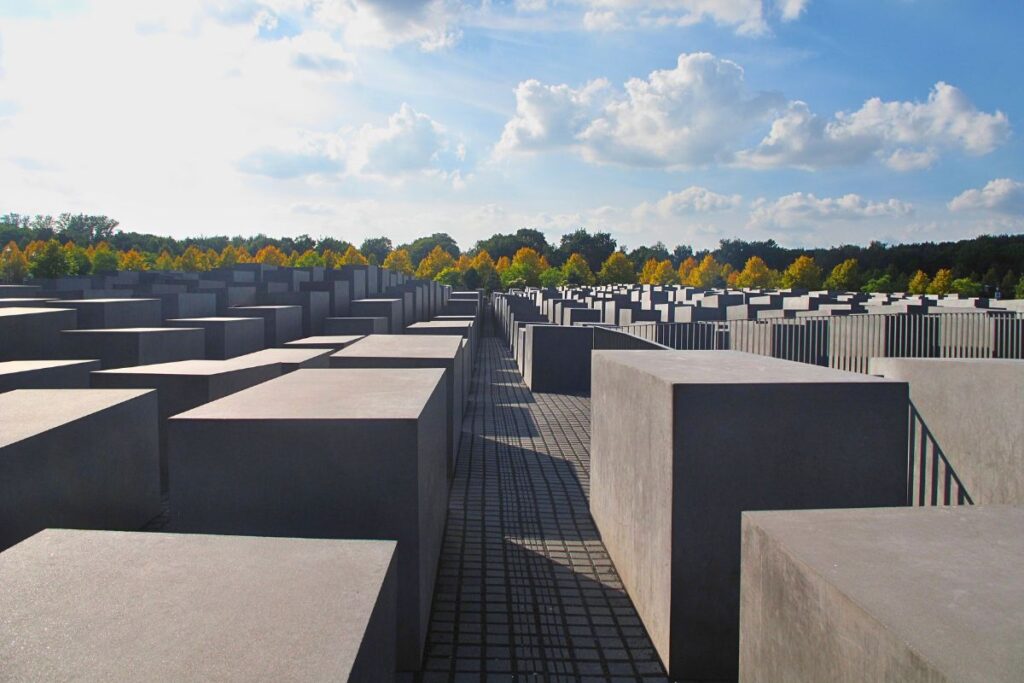
Known locally as the Holocaust Memorial, the Memorial to the Murdered Jews of Europe was built in remembrance of the Jewish people who were killed by the Nazis during World War II.
Resembling a labyrinth of sorts, this outdoor memorial features 2,711 concrete blocks of varying height and size. Visitors are welcome to wander through the space as they reflect upon a darker time in German history.
In addition to this, there’s also an information center located underneath the Memorial. Here, you’ll find a variety of photographs, personal belongings, and biographies of Holocaust victims.
Admire the Views from the Reichstag Building
The Reichstag Building may be home to the German parliament, but it’s also a historic architectural wonder that offers incredible views of the city.
In fact, there are three different visit experiences that you can choose from. You can join a guided tour, attend a public lecture, or simply visit the roof terrace and dome for those unforgettable views.
Admission is free here, but advanced reservation is required.
Check Out Checkpoint Charlie
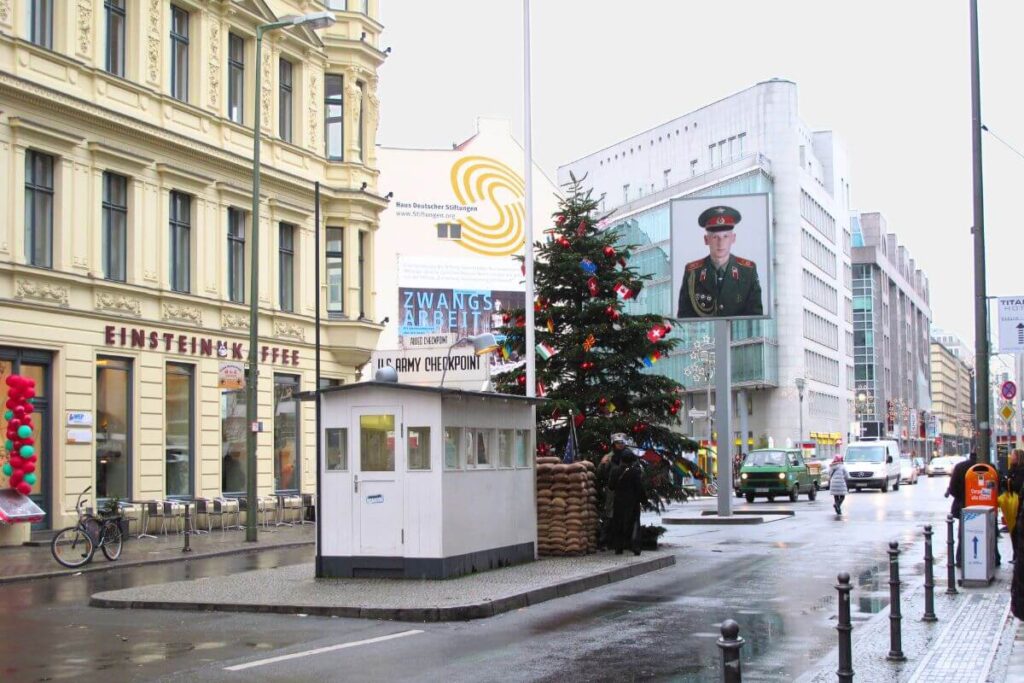
Checkpoint Charlie was, at one point in time, the Cold War’s most important border crossing between East and West Berlin.
Today, the site, which has been restored to reflect its original condition, consists of a replica guard hut complete with numerous sandbags, signage, and flags.
A popular spot for photos, Checkpoint Charlie has been featured in several movies, including James Bond, The Spy Who Came in from the Cold, and Bridge of Spies.
While there isn’t much to do here, aside from snapping a few photos, there is a nearby Checkpoint Charlie Museum that you can visit. Here you’ll learn more about the history of Checkpoint Charlie and the Berlin Wall.
Discover Gendarmenmarkt

Widely regarded as Berlin’s most beautiful square, Gendarmenmarkt is a historic landmark celebrated for its stunning architecture.
Dating back to the 17th century, the square is home to several notable structures, including the French Cathedral, the German Cathedral, and the Konzerthaus (Concert House).
The French Cathedral, in particular, is a popular spot to visit, as it offers incredible views of Gendarmenmarkt and central Berlin.
The square also happens to be a great destination around the holidays, as it plays host to one of Berlin’s most popular Christmas markets.
Please note: Gendarmenmarkt is currently undergoing renovations and may be inaccessible to the public at times. The renovations are scheduled to be completed by the end of 2024.
Day 2: Historial Berlin
On the second day of your Berlin itinerary, we’ll spend more time visiting the city’s historical landmarks. These destinations are a bit spread out, so be sure to give yourself enough time to travel between them.
Explore Alexanderplatz
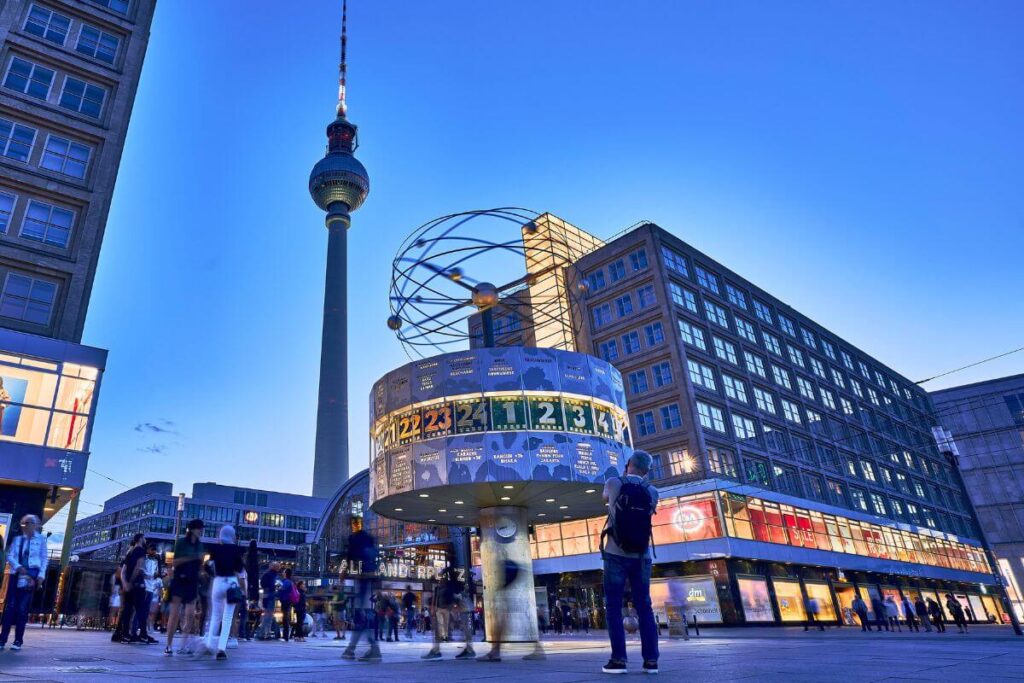
Photo of Alexanderplatz with World Clock & TV Tower by Norbert Braun via Unsplash.
Dating back to the 13th century, Alexanderplatz is not only a historically significant square, it’s also the largest public square in all of Germany.
Throughout the years it’s played a variety of roles, including that of a cattle market, a wool market, and military training grounds. Today, however, it’s home to numerous attractions and amenities, such as shopping centers, restaurants, hotels, and even one of the city’s major train station.
You can also find a few iconic landmarks here. The World Clock, the Fountain of International Friendship, and the Fernsehturm (more on that below) all reside in Alexanderplatz.
And last, but certainly not least, the square is known for hosting various celebrations and events, including Christmas Markets, music festivals, and cultural celebrations.
Pro Tip: While Alexanderplatz is worth visiting, I would advise against booking accommodations in the area. The square gets pretty crowded at times and can be quite noisy and dirty. As such, it’s best to just check out the square in passing – visit the highlights and move on from there.
Take in the Views at the Berliner Fernsehturm
The Berliner Fernsehturm, also known as the Berlin TV Tower, is the tallest building in Berlin. So naturally, it offers the best views of the city.
Standing 368 meters tall, the tower is home to a 360° observation deck, a revolving restaurant, the highest bar in the city, and a virtual reality experience.
Advanced reservations for the observation deck and the restaurant are highly recommended.
Visit the Berlin Wall Memorial
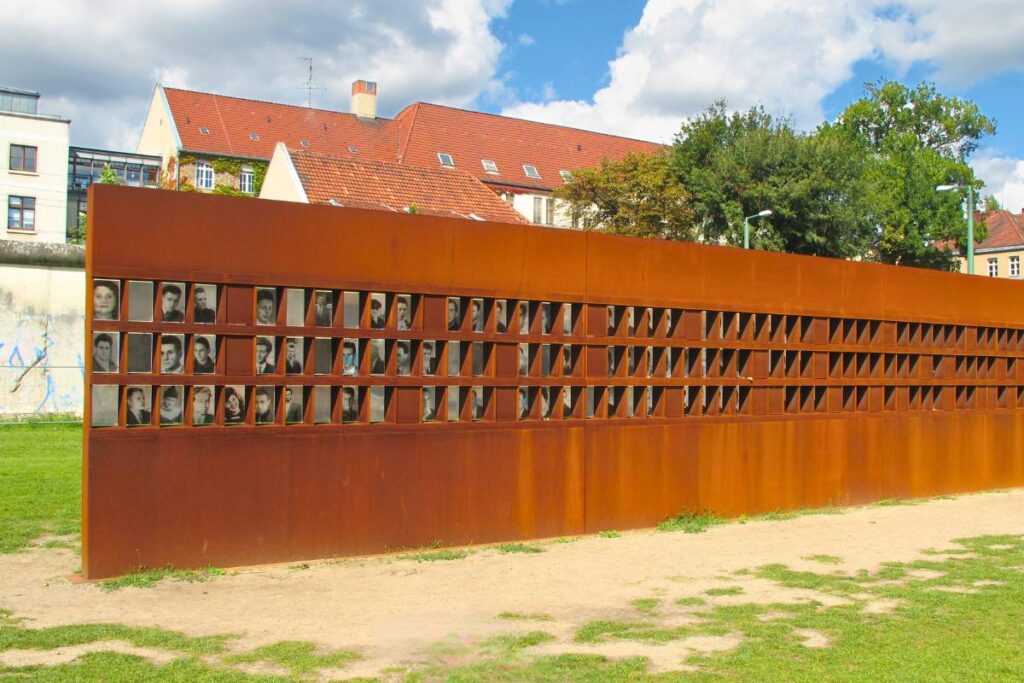
Encompassing 1.4 kilometers of the former border wall, the Berlin Wall Memorial aims to commemorate the division that once existed within the city.
An open-air gallery, the memorial features remnants of the original Berlin Wall along with an observation tower and visitor’s center.
Here, you can learn about the rapid construction of the Wall and the impacts that it had on the city. And you can also hear stories about the heartbreaking attempts people made to cross the border in hopes of reuniting with family.
Admire the East Side Gallery
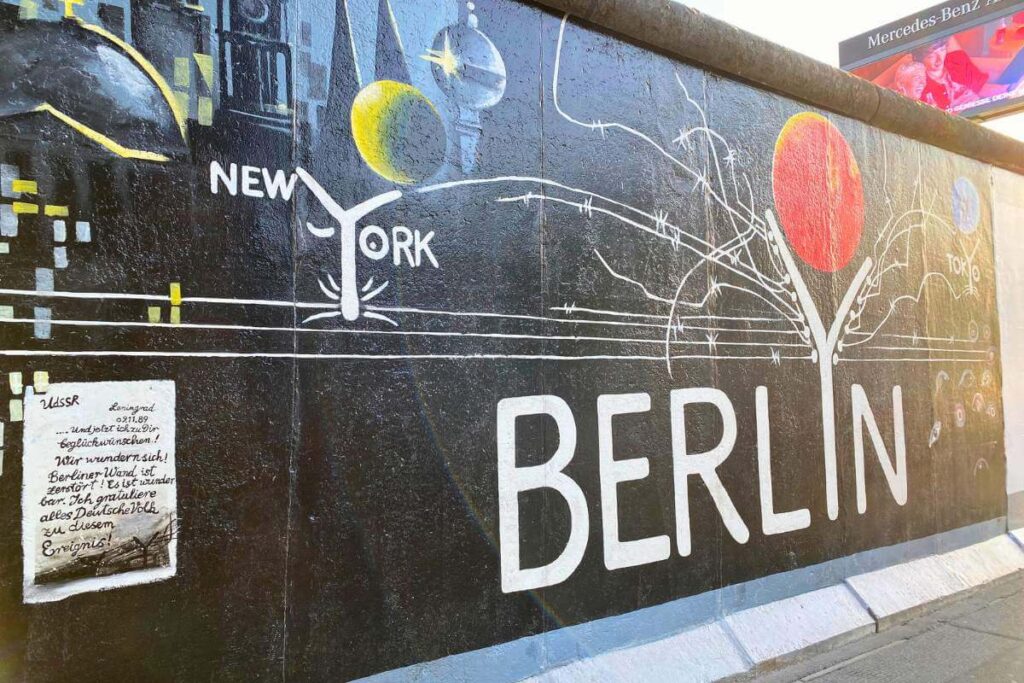
Spanning 1,316 meters, the East Side Gallery is the longest continuous section of the Berlin Wall still in existence today. It also happens to be the longest open-air gallery in the world.
Featuring more than 100 paintings, the East Side Gallery was created through the combined efforts of approximately 118 artists from across 21 countries.
Created shortly after the fall of the Berlin Wall, many of the paintings featured in the gallery depict images and messages of peace and unity.
Join a Food Tour
The city of Berlin is home to a number of incredible restaurants, food trucks, and eateries. And one of the best ways to find them is on a food tour. So instead of heading out on your own for dinner, consider joining one of these tours instead!
Here are a few popular Berlin food tours that I’ve come across:
- Berlin Walking Food Tour With Secret Food Tours
- East Berlin Food & History Tour with Eating Europe
- The 10 Tastings of Berlin With Locals: Private Food Tour
- Classic Bites and Culinary Trends Neighborhood Food Tour in Berlin
- Kreuzberg: Culinary Food Tour
And for those interested in exploring Berlin’s beer scene, there are also craft beer tours and craft beer with food tours!
Day 3: Museum Island
The third day of your 4-day Berlin itinerary is all about museums. We’ll head over to Museum Island, which is a UNESCO World Heritage Site in and of itself. Here, you’ll find a variety of museums and landmarks to visit. Pick a few that interest you and make a day of it!
Berlin Cathedral
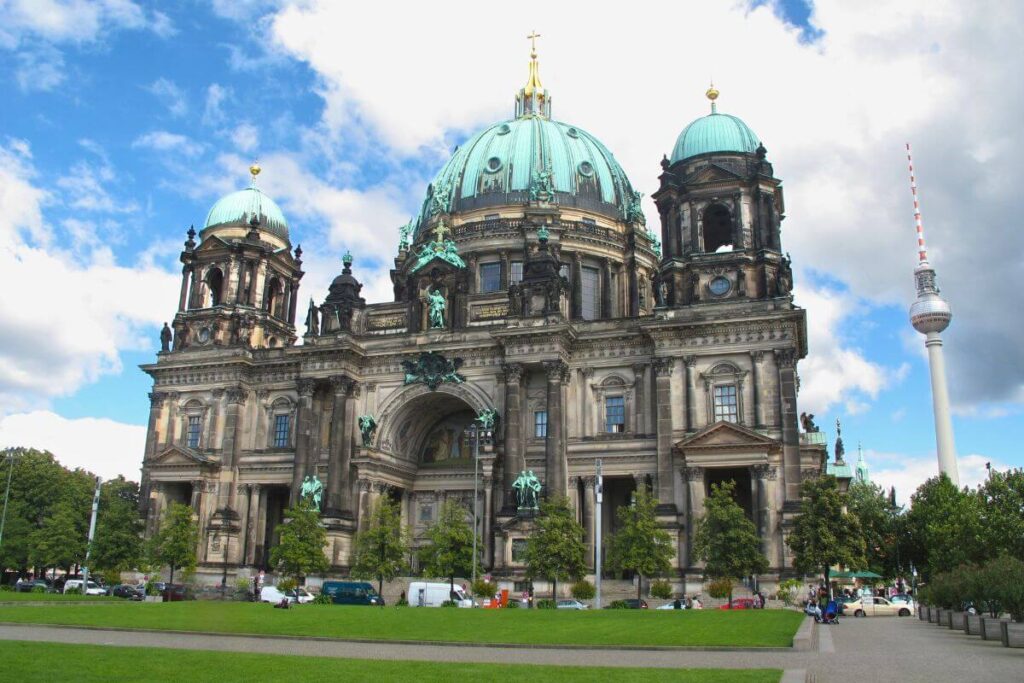
Also known as the Berliner Dom, the Berlin Cathedral is an iconic landmark that has come to symbolize Berlin.
Originally built by the royal Hohenzollern family in the 15th century, the church has been reconstructed and restored several times throughout history. The version we see today was erected at the end of the 19th century but retains some of its original features, including the Hohenzollern family crypt.
Visitors to the Cathedral are welcome to tour the church when religious services are not in session. There’s even a 360° panoramic viewing platform located within the dome that you can check out – although it does require a steep climb up 270 steps!
Please note: The church’s crypt is currently closed for renovation work. It is scheduled to reopen to the public sometime in 2024. The rest of the church remains open to visitors.
Altes Museum
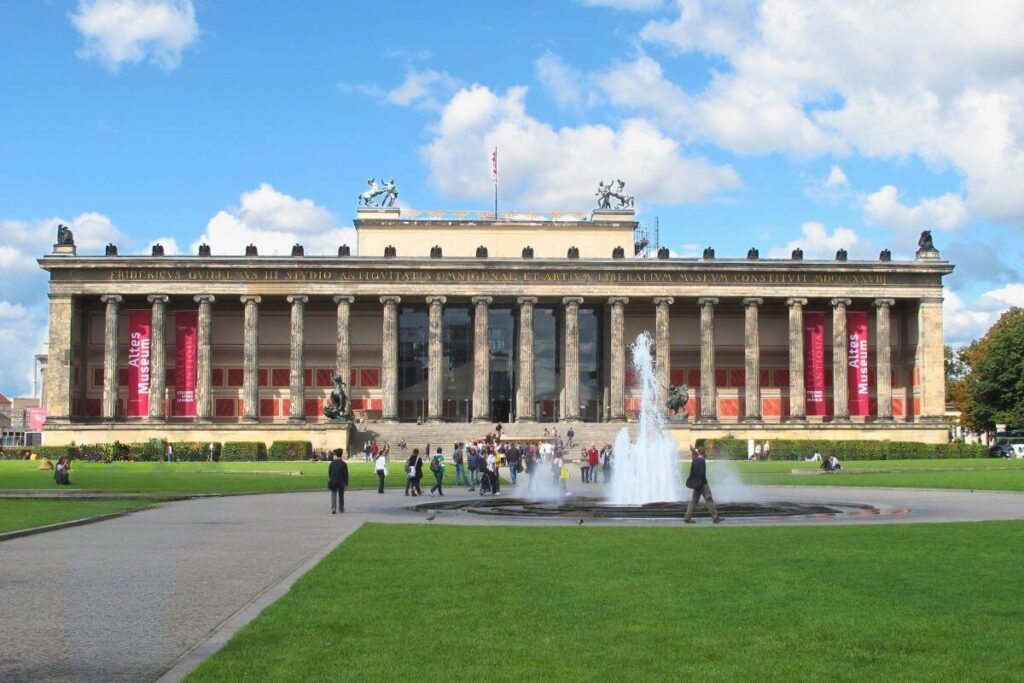
The Altes Museum (or Old Museum) dates back to 1830 and houses a variety of ancient artifacts from the Roman, Greek, and Etruscan eras.
The museum is home to two main collections: the Collection of Classical Antiquities and the Münzkabinett (or Coin Cabinet). Together, these collections feature thousands of artifacts ranging from jewelry to vases, sculptures, artwork, and an impressive collection of ancient coins.
Of particular note is the museum’s Etruscan art collection, which is the most extensive collection outside of Italy. In addition to this, the museum also houses historic busts of Caesar and Cleopatra from Ancient Rome.
Neues Museum
The Neues Museum (or New Museum) offers a glimpse into the past, featuring a variety of exhibits ranging from the Stone Age to the Middle Ages.
Most known for its Egyptian Museum and Papyrus Collection, the museum also houses a Museum of Prehistory and Early History collection, as well as several temporary exhibits and displays.
Some of the museum’s most popular artifacts include a limestone bust of the Egyptian Queen Nefertiti, a 700,000-year-old ax head, and several silver vessels believed to be from Ancient Troy.
Bode Museum
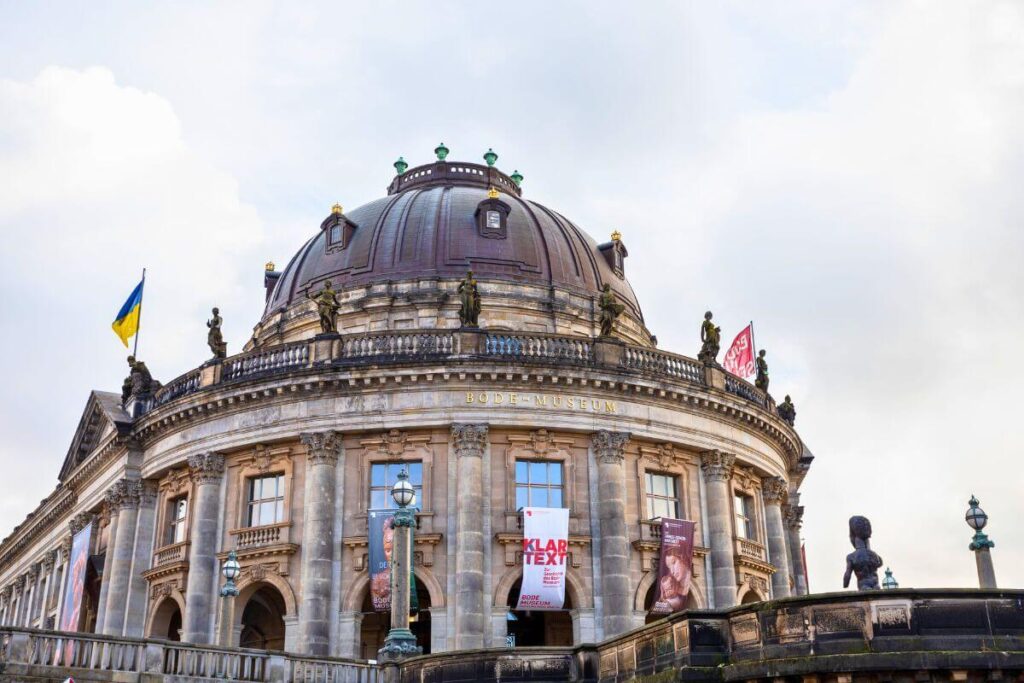
Photo of Bode Museum by Julius Weidenauer via Pexels.
Formerly known as the Kaiser Friedrich Museum, the Bode Museum reopened in 2006 after becoming significantly damaged during WWII.
Today, it houses two main collections: the Sculpture Collection and Museum of Byzantine Art, as well as the Numismatic Collection, which features a variety of historic coins and medals.
A few of the museum’s most notable artifacts include a 12th-century mosaic from Constantinople, two Ancient Roman sarcophagi, and “Pazzi Madonna,” a marble sculpture from Italian artist Donatello.
Pergamon Museum
Renowned for its archeological artifacts, the Pergamon Museum is one of Berlin’s most popular and most visited museums.
Here, you’ll find three major collections: the Collection of Classical Antiquities, the Museum of the Ancient Near East, and the Museum for Islamic Art. Each of these exhibits, most notably, feature full-scale reconstructions of historical monuments and architectural structures.
Some of the museum’s most famous displays include the Pergamon Altar from Ancient Greece, the Ishtar Gate from Babylon, a market gate from Ancient Rome, and the facade of a Jordanian desert palace.
Please note: The Pergamon Museum will be closed until spring 2027 for major renovations. However, the Pergamon Museum: the Panorama, which is an offshoot of the main museum, is open and accepting visitors.
Alte National Gallery
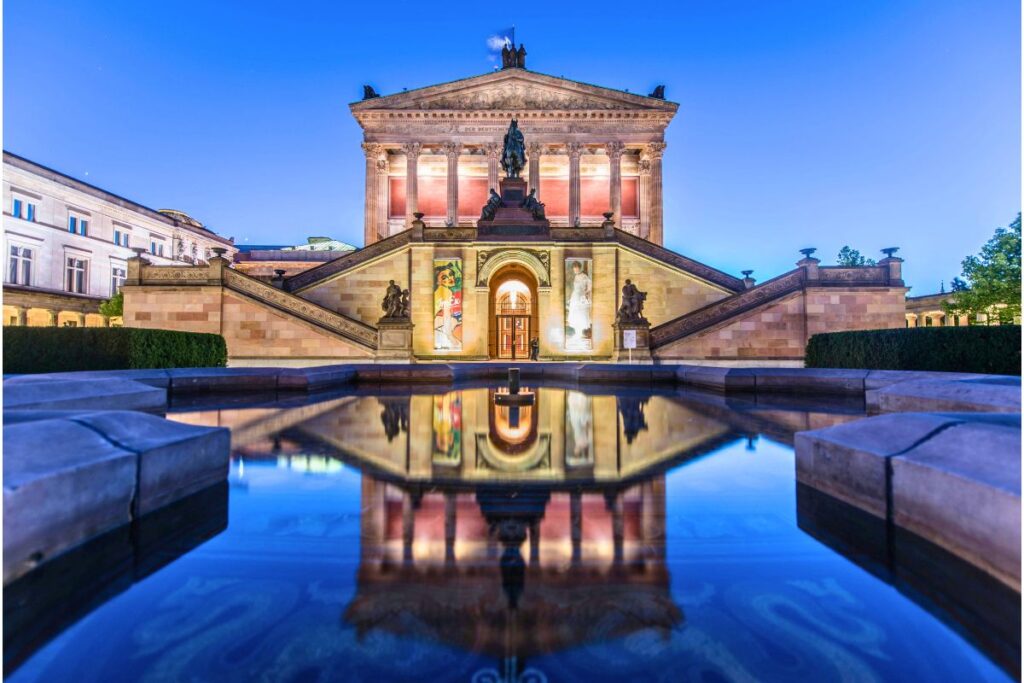
Photo of Alte National Gallery by Snapwire via Pexels.
Also known as the Old National Gallery, the Alte Nationalgalerie is home to one of Germany’s largest and most important collections of 19th-century art.
Here, you’ll find approximately 1,800 paintings and 1,500 sculptures from some of the world’s most famous artists, including Claude Monet, Édouard Manet, Adolph Menzel, and Caspar David Friedrich.
And, of course, you don’t want to overlook the building itself, which was designed and constructed to reflect that of an ancient temple.
DDR Museum
While it’s not located on Museum Island, the DDR Museum is situated just around the corner and deserves a quick mention.
With a focus on immersive experiences, this unique museum offers the opportunity to step back in time and experience what life was like in former East Germany.
Here, you can walk through a traditional apartment building, listen to East German propaganda, view a model of the Palace of the Republic, and even go for a simulated ride in East Germany’s signature car – a Trabi.
Day 4: West Berlin Highlights
On the final day of your Berlin itinerary, we’ll head over and explore West Berlin. I recommend beginning your morning at Charlottenburg Palace and traveling east as you hit up the other attractions. You can then end your day with an evening cruise along the Spree River.
Explore the Grounds of Charlottenburg Palace


Dating back to the 17th century, Charlottenburg Palace was named after Sophie Charlotte, the first Queen consort in Prussia.
The largest palace complex in Berlin, Charlottenburg was a favorite retreat among many royals, who utilized it as a summer residence.
Today, the Palace and its grounds are preserved and open to the public. Visitors are welcome to walk along the ornate halls of the Palace, learn about its impressive history, and wander through its meticulously designed royal gardens.
Visit the Kaiser Wilhelm Memorial Church
Built by the Prussians in the late 1800s, Kaiser Wilhelm Memorial Church is not only a historic site, it’s one that also sends a sobering message.
Largely destroyed during WWII, the church’s original tower remains in a ruined state and serves as a reminder of the horrors of war.
For those interested in exploring the church’s ruins, guided tours are offered on a daily basis.
Wander Through the Tiergarten Park
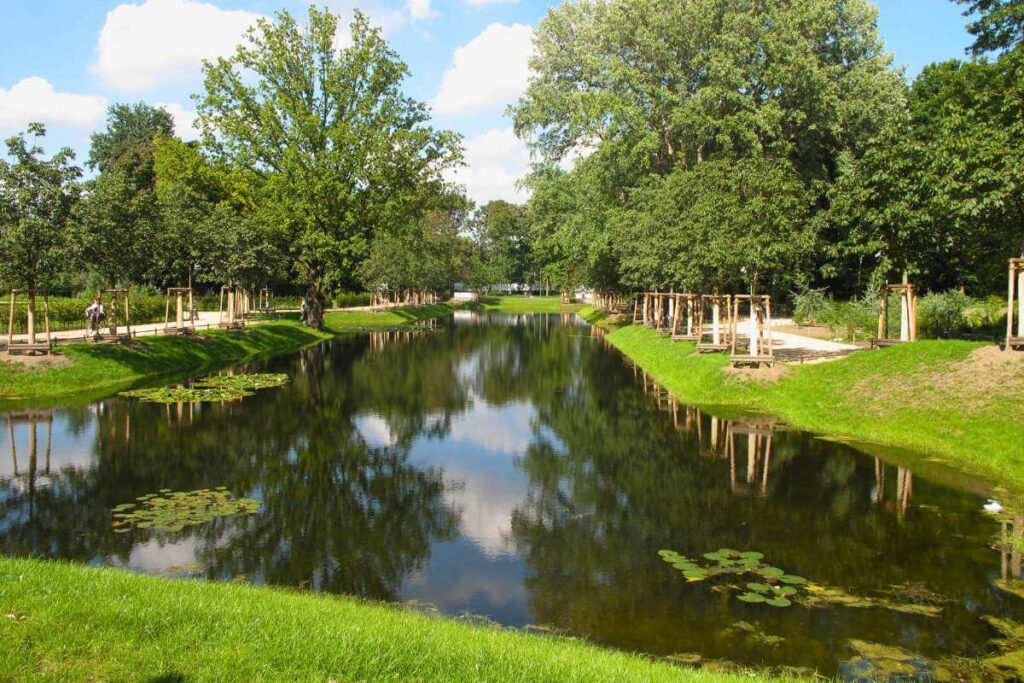
Encompassing nearly 520 acres, Tiergarten Park is one of Berlin’s largest and most famous green spaces.
The former hunting grounds for Prussian royalty, the park now serves as a community space complete with ponds, open lawns, and an expansive network of tree-lined paths.
In addition to this, the park is also home to several attractions and monuments, including the Berlin Zoo, the Soviet War Memorial, the House of World Cultures Art Center, and the Victory Column, which offers incredible views of the city.
Go for a Cruise Down the Spree River
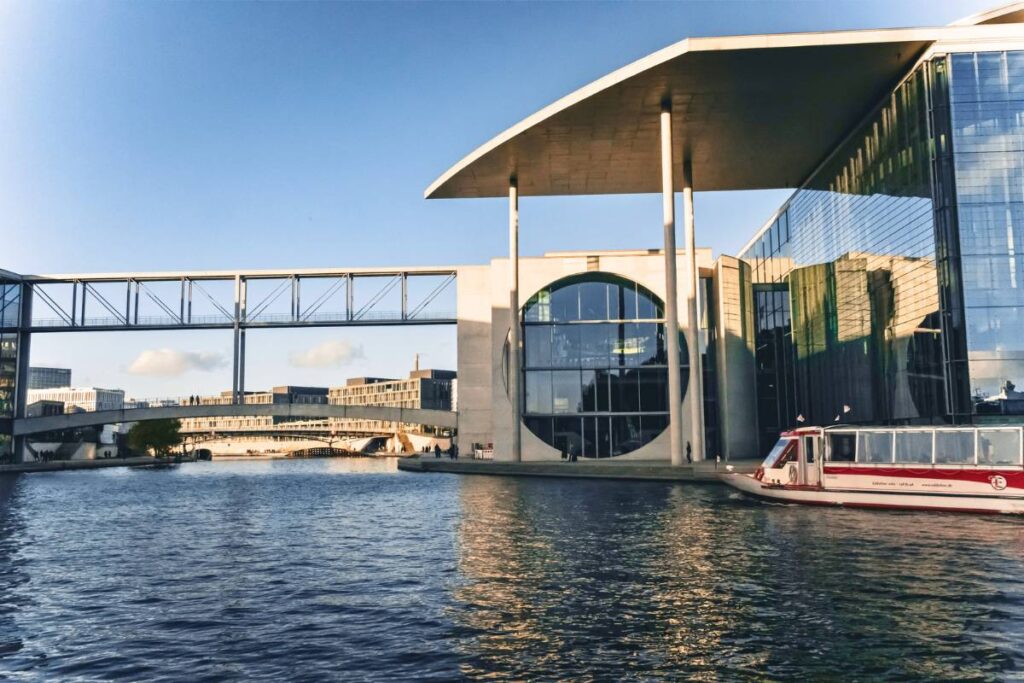
Photo of Spree River by Dimitri Frixou via Unsplash.
If you have time in the evening, consider going for a cruise down the Spree River.
Winding through the center of Berlin, the Spree offers incredible views of the city. And one of the best ways to take in those views is from the comforts of a boat. Luckily, Berlin offers a variety of cruise tours that you can join!
Here are a few popular options for you to consider:
- 1-Hour City Tour by Boat with Guaranteed Seating
- 2.5-Hour East Side Boat Cruise with Commentary
- Christmas Sightseeing Cruise with Welcome Drink
- Guided Tour by Canoe
Regardless of which you choose, a river cruise is a great way to wrap up 4 days in Berlin!
5 Amazing Day Trips from Berlin
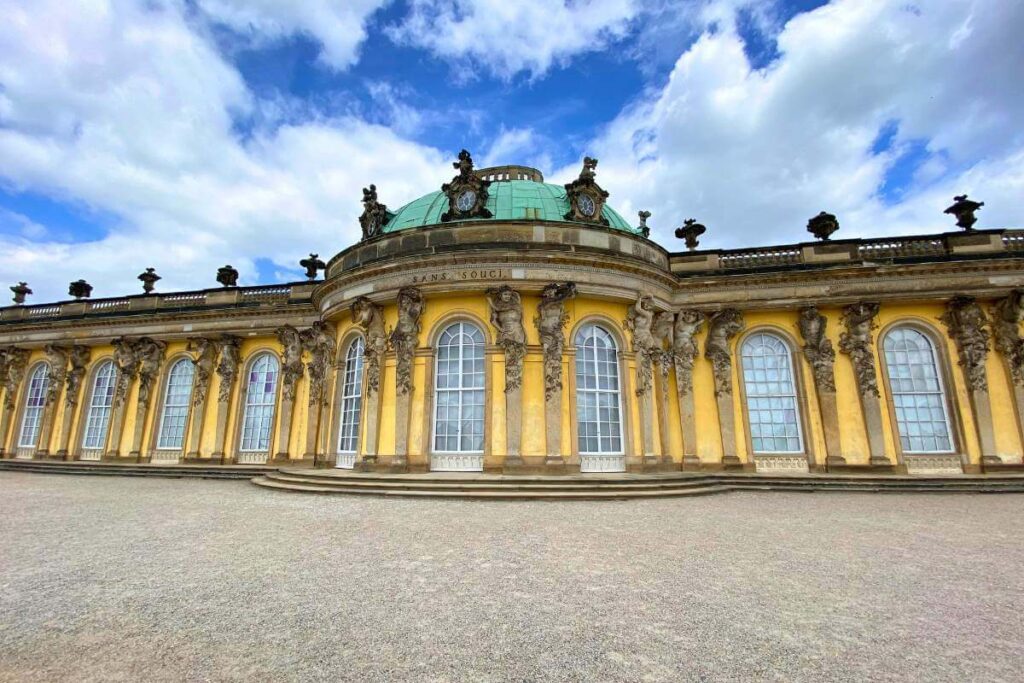
Sanssouci Palace in Potsdam is a popular destination near Berlin.
Interested in extending your Berlin itinerary beyond 4 days? Then consider visiting one of these destinations. They’re all easily reachable by train and offer a variety of incredible experiences!
- Potsdam: Once the imperial capital of Prussia, Potsdam is now a UNESCO World Heritage Site. Known as the “Versailles of Germany,” the city is home to more than 1,200 acres of preserved parks, 150 historic buildings, and a staggering 17 palaces.
- Sachsenhausen Concentration Camp: Situated in the town of Oranienburg, Sachsenhausen was a forced labor and concentration camp operated by the Nazis from 1936 to 1945. Today, the camp is preserved as an open-air museum and Memorial.
- Leipzig: Located about an hour south of Berlin, Leipzig is a thriving metropolis known for its rich cultural and musical history. Here, you’ll find a variety of beautifully preserved historical buildings, a plethora of museums, numerous art galleries, and an impressive array of musical and artistic events.
- Spreewald: A UNESCO Biosphere Reserve, Spreewald encompasses more than 110,000 acres of forests, meadows, and riverways. Known for its outdoor attractions, the reserve offers activities such as kayaking, hiking, biking, and paddleboarding.
- Wannsee Lake: A popular summer destination, Wannsee Lake is situated less than an hour from central Berlin. Home to nearly a mile of sandy shores, the lake is a great place to enjoy numerous recreational activities, such as swimming and boating.
Where to Stay in Berlin
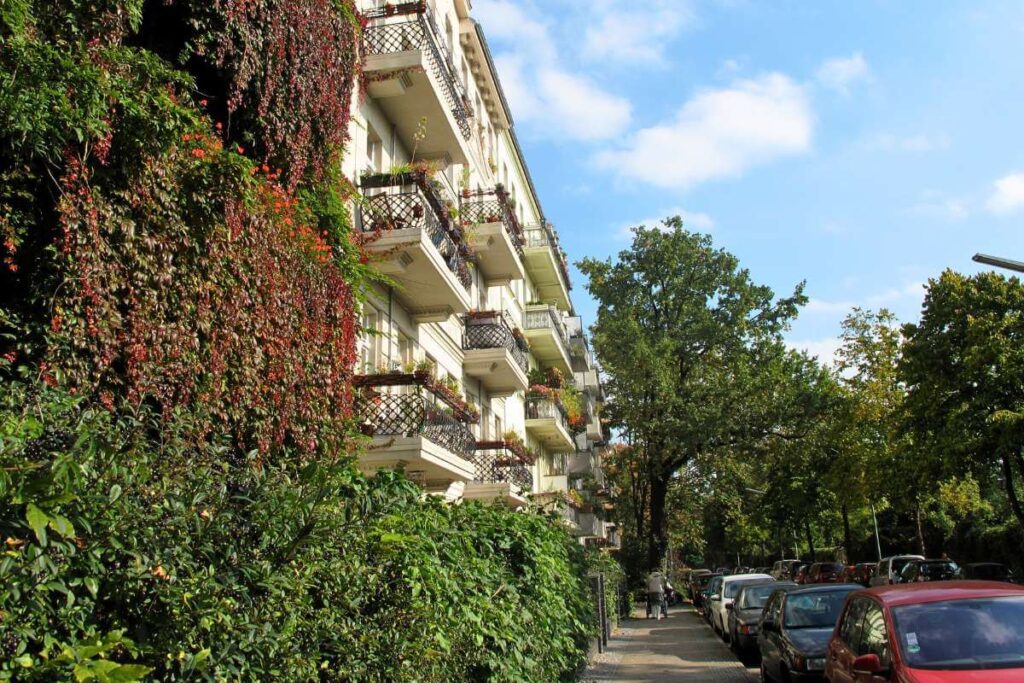
Kreuzberg is a great place to stay in Berlin.
Berlin is a large city, so there are several options for you to consider when it comes to accommodations. Which area of the city you choose will largely depend on your budget, itinerary, and personal preferences. That being said, I’ve included below some of the most popular places to stay in Berlin for 4 days.
- Mitte: Centrally located, Mitte is likely to be one of the most expensive neighborhoods in Berlin. However, it’s also the most convenient, as it offers easy access to many of the city’s attractions.
- Prenzlauer Berg: Perfect for those traveling with children, Prenzlauer Berg is very family-friendly. Here, you’ll find a plethora of parks, numerous playgrounds, and a more relaxed atmosphere.
- Kreuzberg: Known for its young, hip vibes, Kreuzberg offers some of the best nightlife in the city. It’s also developing a bit of a reputation as a cultural hub, given its wide variety of art galleries and music venues.
- Friedrichstein: Situated in east Berlin, Friedrichstein is home to a variety of affordable accommodations, restaurants, and bars. It’s an ideal spot to stay if you’re traveling on a budget.
- Charlottenburg: Home to several residential communities, Charlottenburg offers a quiet, more upscale atmosphere. Here, you’ll find several high-end shops, cafes, restaurants, and accommodations.
What to Eat in Berlin
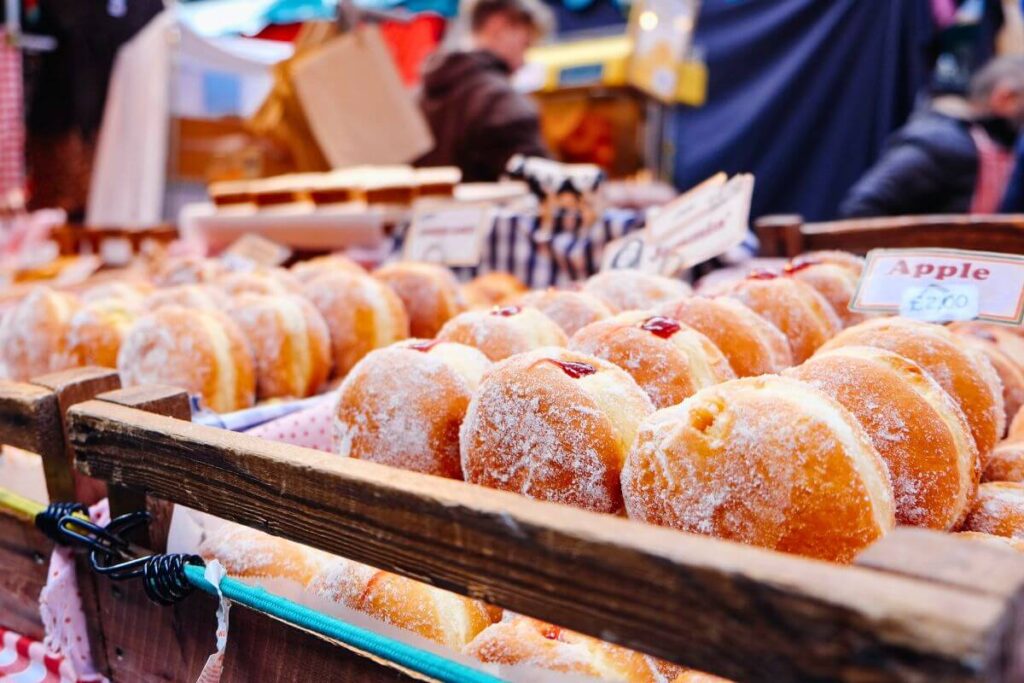
Photo of donuts by Leon Ephraïm via Unsplash.
While visiting Berlin, you’ll definitely want to set aside some time to sample the local cuisine. And believe me when I say there’s lots of delicious food you can try here! To help you narrow down your options, I’ve provided below a list of my favorite must-try dishes in Berlin.
- Currywurst: A popular street food, currywurst is grilled sausage that’s chopped up and covered in ketchup and curry powder. It’s usually served with french fries and makes for a great on-the-go snack.
- Döner Kebab: Of Turkish origin, a döner kebab is made of rotisserie-cooked meat that is placed into pita bread and accompanied by an assortment of vegetables and sauces. While there are small döner kebab restaurants spread throughout the city, some of the best kebabs I’ve had have come from street vendors.
- Berliner Donut: Made fresh daily, Berliner donuts are fried donuts filled with jelly and topped with powdered sugar. These donuts are the perfect option for anyone in search of a quick, sweet breakfast.
- Brezel: Also known as German pretzels, brezels are essentially large, soft-baked pretzels. Made of knot-shaped dough, they are topped with salt and can be served with cheese or butter and chives.
- Schnitzel: While technically an Austrian invention, schnitzel is a popular dish served throughout Germany. Made of thinly sliced veal or pork, the meat is breaded, deep-fried, and served with slices of lemon.
- Kartoffelpuffer: A pan-fried potato pancake, kartoffelpuffer is made from grated potatoes, onion, flour, eggs, and spices. It can be served with a variety of toppings, including applesauce, sour cream, and smoked salmon.
- Ritter Sport: Offering a myriad of flavors, this German chocolate is an absolute must for anyone with a sweet tooth. You can find these chocolate bars at many grocery stores or at the company’s flagship shop in Mitte.
Frequently Asked Questions About Visiting Berlin in 4 Days
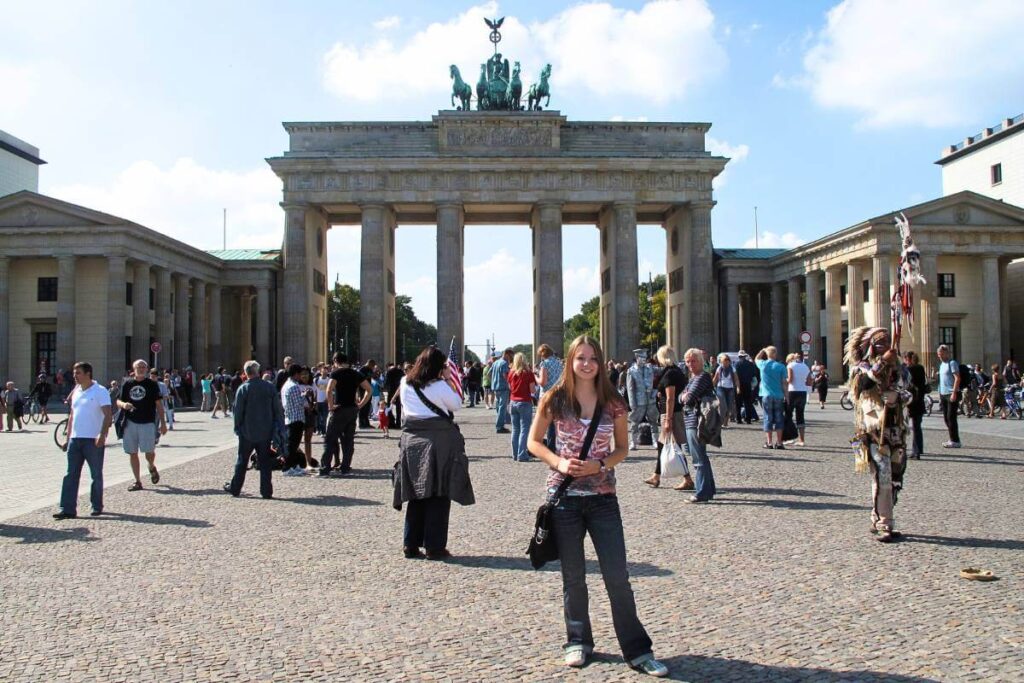
One of the first photos taken of me in Berlin when I moved there to study abroad in 2010!
Here are my thoughts on some commonly asked questions about planning an itinerary for Berlin.
Is Berlin Worth Visiting?
Without a doubt, Berlin is definitely worth visiting! There’s so much to do and see here – and the history is absolutely incredible. On top of that, the city offers phenomenal nightlife, unforgettable local cuisine, and rich cultural experiences. There really is something for everyone in Berlin!
Is 4 Days Enough in Berlin?
While it would likely take weeks, maybe even months, to explore all that Berlin has to offer, 4 days is the perfect amount of time to hit up the highlights and get a feel for the city. With 4 days in Berlin, you’ll have just enough time to visit the city’s main attractions, sample its local cuisine, and experience its culture.
How Safe is Berlin for Tourists?
Berlin is considered to be a very safe city for tourists. Like any other major urban area, you should still exercise standard safety precautions to prevent crimes such as pickpocketing and petty theft. But, generally speaking, the city is a very safe destination to visit.
Is Berlin Budget Friendly?
Compared to many other European cities, Berlin is incredibly affordable. There are a variety of budget-friendly accommodations and hostels that you can take advantage of. On top of this, the city is home to many cheap and even free attractions and activities.
Is Berlin Better Than Munich?
Both Berlin and Munich are incredible cities that are worth visiting. If you have the means to do so, I highly recommend including both of them on your German itinerary. But if you can’t, what should you do? Well, that depends on what you’re looking for. In short, Berlin is a larger city that offers much more to do in terms of attractions and activities. Conversely, Munich is smaller but more traditional, so you’d have more opportunities to immerse yourself in the German culture here.
Final Thoughts: Berlin in 4 Days
So there you have it – my top recommendations for exploring Berlin in 4 days! Hopefully, this guide is helpful in planning your own trip to Germany’s capital city.
Regardless of what you decide to do, I have no doubt that you’ll have an unforgettable time. After all, Berlin is an absolutely incredible city, one that is sure to excite and inspire you!
Have you been to Berlin? Is there anything you’d add to this 4 day Berlin itinerary? Let me know in the comments below?
Love this post about Berlin in 4 days? Pin it now for later?
